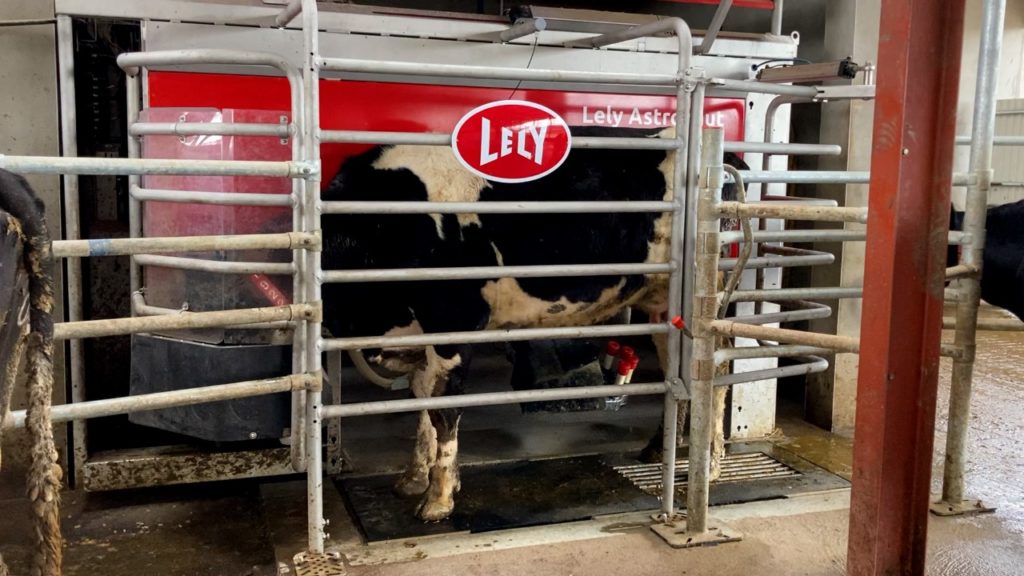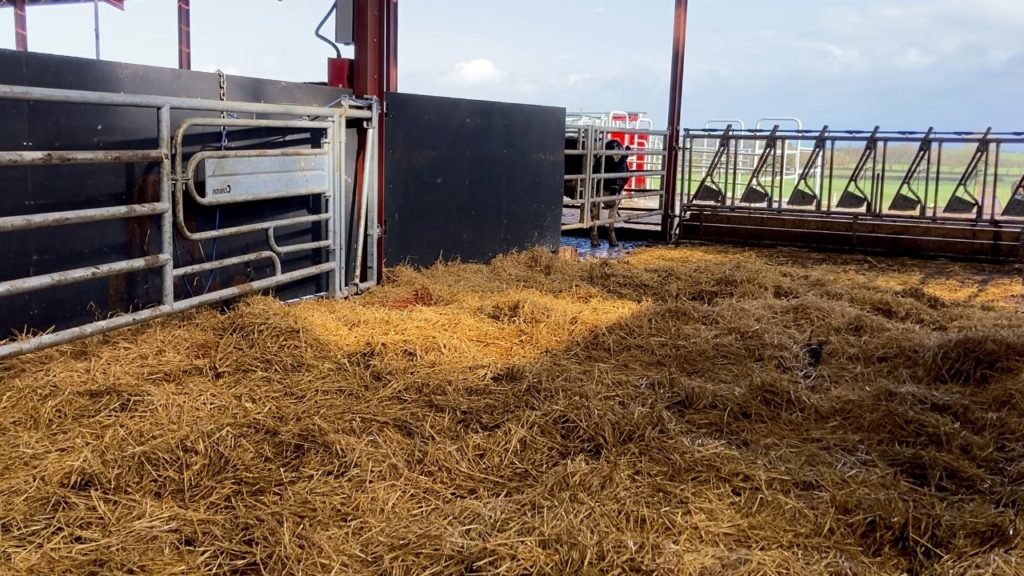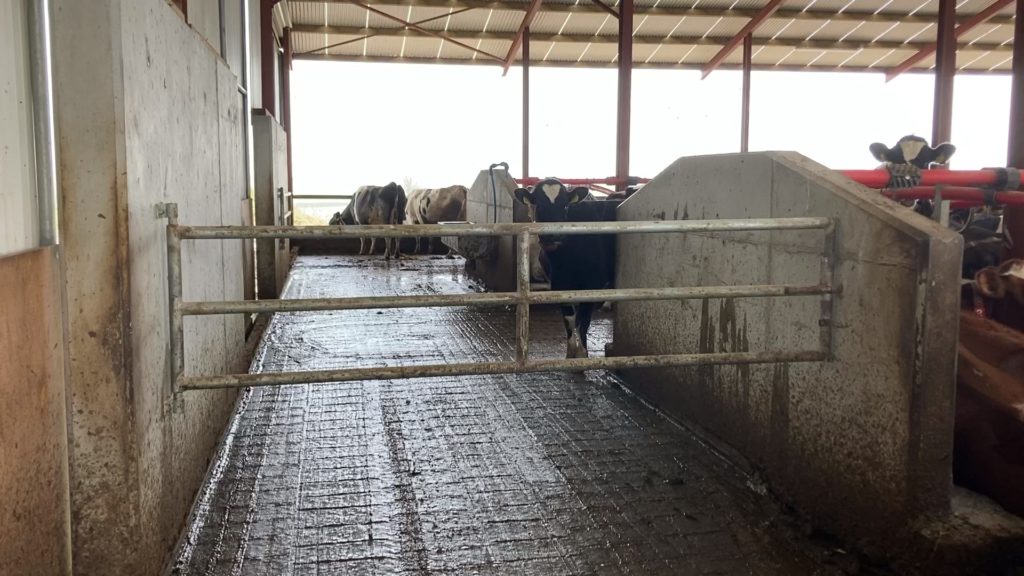This week’s Buildings Focus saw Agriland make the trip to Ardagh in Co. Limerick to speak to Jerome O’Connor and his parents regarding their new dairy unit.
Jerome, alongside his father Jim and mother Nuala, milked 95 cows last year and this year, is calving down 105 cows.
Up until last year, the trio, who are in partnership together, used to milk up to 70 cows in a 6-unit parlour, with Jim and Nuala originally starting out milking 30 cows.
Alongside the dairy enterprise, the Limerick natives keep all of their calves they produce and anything that wasn’t for breeding was kept and originally brought to beef. Now however, they are brought to forward stores.
Getting back to the dairy side of the farm, since Jerome returned home five years ago from stints in New Zealand and the US, he set out to look at improving on the existing facilities on the farm, including the milking and housing facilities, in order to expand cow numbers.

Speaking to Agriland on his farm during the week, Jerome said: “Up until milk quotas were abolished in 2015 we were milking 30 cows, and then when we had room to expand we were milking up to 70 cows.
“However, overall, the farm needed updating across the board. The parlour we had did the job but we wanted to expand further and our old parlour just wouldn’t be able to handle that many more cows.
“Furthermore, we were feeding our cows during the winter with round feeders and it was a hard slog with the Massey Ferguson 135 in the winters, especially as cow numbers crept up.
“So in 2020, we sat down and assessed our options and looked at what we could do in order to increase cow numbers further, in order to have an income for all three of us involved and to streamline and simplify the business that would make our lives easier – and also free up more time for ourselves.”
What the O’Connor’s decided on
After some deliberation on what they would do next, Jerome and his parents decided on going with a greenfield site that would see them move towards a robotic-milking system.
This decision wasn’t made lightly and, although Jerome was in favour of the move from the get go, his parents were a little more hesitant. Their hesitation was mainly down to the sheer size of the job that it was going to take to make this dream come true.
Jerome said: “I have four siblings, and the 30 dairy cows and the drystock we had on the farm put food on the table for us and put us all through college, so it wasn’t an easy decision for my parents as what we had had served both them and my siblings very well.
“However, I was committed to the farm and had a passion for it and I knew that in order to push on the business for all three of us to make a living from it, that we had to look at improving on what we had.
“This involved us going in a different direction to what we had done previously and really and truly getting out of our comfort zone.
“So we said we would go with a greenfield site and basically have a shed that would house all our cows, have a crush, calving area, calf housing (in time) and facilities to milk our cows, which led us down the route of robots in the end.”

The layout of the new dairy unit
Jerome knew what he wanted in his head and with the help of Crowley Consultants and Lely Mitchelstown, he was able to get what he wanted in his head, down on paper for work to get started on.
Initial digging of the site began in June 2020 in a paddock that was closest to the existing yard.
Below is a detailed drawing of what the O’Connors have on their farm today.

Looking at the dimensions of the shed, it measures 52.8m long and 40.75m wide.
Looking at the cubicle section of the shed, there are 156 cubicles in total; 142 of which are located in the main section of shed, with the other 12 found in the treatment area.
The 142 cubicles are split up into three rows, with 48 cubicles in each row.
In order to split up areas of the shed and have the option of keeping different groups of cows together, a break, about two-thirds down each of rows was incorporated to allow for cows to move between each row of cubicles.
The outer passageways of the shed between the feed passageways measure 4.2 wide, with the passageways in between each of the rows of cubicles measuring 3m.
All the cubicles, which are back-to-back, measure 2.4m long and 1.2m wide.
Two slatted tanks were installed; one is located in front of the two robots and measures 150ft long and the other is halfway down the main cubicle area, measuring 130ft. Both tanks are 9ft deep.

Taking a look inside the shed
The shed can be broken down into two main sections. The first section comprises the two robots; the separation area, which contains 12 cubicles; a large calving pen; a crush; and the office and bulk tank rooms.
The other main section of the shed consists of the cubicles and feeding passageways.
Looking at the two robots first, Jerome and his parents opted to install two Lely Astronaut A5 robots from Lely Center Mitchelstown, which divert milk into a 12,000L bulk tank.

The main reason why Jerome chose to go with robots rather than a parlour, which he had considered also, was mainly down to labour.
He said: “Robots we felt offer more flexibility and are less labour intensive compared to a parlour.
“The features of the robot have made managing cows much easier for us. The information you get about each individual cow is great and the robots pick up if a cow isn’t herself, for example like not eating, quicker than we would if we were milking in a parlour.
“The heat detections is a feature we find great. When you come out in the morning, the robots will have cows drafted out to the separation area for us which saves a lot of time and labour.
“The cows transitioned well to the robots and we are still learning ourselves about them and all the information we can make use of from them.”
Cows that need to be treated for example or are in heat, can be drafted from either robot, down a narrow passageway that diverts cows into a separation area that contains 12 cubicles and a large standing area.
Behind the cubicles is a crush that can be used for a variety of jobs and it is located in a convenient area to be accessed for any cows that have been drafted into the separation pen.
The calving pen can also be accessed from the separation area or from the main cubicle section of the shed. Stockboarding was fitted along the crush and also around the calving pen.
In the calving area and in the separation, headlocking barriers were installed, while the rest of the feeding space has a single bar running the length of the shed – each side.
Looking to the main cubicle area of the shed, cow comfort was one area Jerome and his parents placed a considerable amount of emphasis on.
They went with easyfix calm cubicles, with a single layer mattress for the 144 cubicles in the main part of the shed, while a double mattress was incorporated into the 12 cubicles in the separation area just for extra comfort for cows that are close to calving for example.
Jerome added: “The cows have taken to the cubicles really well and seem to be really happy on them. When the cows are fed, all you’ll see is them migrate back to the cubicles and you wouldn’t hear a peep out of them, even when you’d be walking through them.
“They are a flexible cubicle which is great and allows for greater cow comfort, as they cows aren’t hitting off metal like with the cubicles we had in the old shed.”
The O’Connors have their cows split up in two, with cows in milk on one side and in-calf cows on the other side.
Jerome is able to split up the shed into many different sections with the help of up and over gates which are installed up the top end of the shed near the robots. This is basically to avoid having a situation where you would be cutting off access to one of the robots by having these gates fitted here.
Elsewhere in the shed, in order to divide it up further, 2-bar gates can be found hung to the walls.
Spaced sheeting was installed over two-thirds of the shed, which covers basically the main cubicle area of the shed. While in t he other third of the shed, where the robots are, spaced sheeting was avoided in case any rain was to fall onto any electricals. Instead, skylights were installed to brighten up this area.

Cost
Jerome and his parents qualified for a grant under the Targeted Agricultural Modernisation Scheme (TAMS II).
Only for being eligible for a grant, Jerome said it would have been a much harder decision to go ahead with the plans they had and that if they hadn’t got the grant, they would have had to look at other cheaper alternative options or build what they have today in stages.
The overall cost of the new dairy unit is standing to the O’Connors at €380,000 when the value of the grant and the VAT is deducted.
Steelcon Construction supplied and stood the shed. The slats were supplied by Banagher slats and all the gates, barriers and headlocking barriers were sourced from Condon Engineering by Jim O’Gorman.
The plumbing and electrical work was carried out by Liam Chawke, while Con Mullane supplied and fitted the hoppers and augers for the meal to the robots.
Speaking about the decision to go ahead and build the new dairy unit, Jerome said: “We are very happy we went ahead, especially with the way the cost of building materials have gone.
“It’s going to take time to fully settle in, we are only approaching the end of year one, but so far, we are happy with how it has gone so far.
“It’s a big investment but we needed to upgrade on our current facilities and hopefully if milk prices stay strong, it will be a worthwhile investment.”












